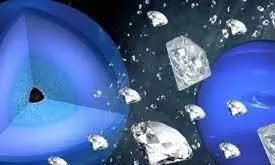
Ice giant planets may have diamond rain, says new study
text_fieldsScientists exploring the atmospheres of distant ice giants like Uranus and Neptune have uncovered a compelling possibility: these celestial bodies might encounter diamond rain within their skies.
Previous investigations into this phenomenon yielded conflicting outcomes, some necessitating extreme conditions.
However, a recent study, led by Dr. Mungo Frost from California's SLAC research centre, employed a novel approach involving the gradual compression of a Styrofoam-like substance using intense X-ray pulses.
This method revealed that diamonds could potentially materialise under conditions akin to those found in the shallower layers of Uranus and Neptune. This revelation heightens the prospect of diamond precipitation on these planets and implies its potential role in shaping their internal composition and magnetic fields.
Moreover, the study posits the likelihood of diamond rain on gas planets smaller than Uranus and Neptune, often referred to as "mini-Neptunes." While absent in our solar system, these mini-Neptunes are observed as exoplanets beyond it.
Published in the journal Nature Astronomy, this research holds significance in understanding the complexities of celestial bodies. "The diamond rain probably has an influence on the formation of the complex magnetic fields of Uranus and Neptune," noted Dr. Frost.
The collaborative effort involved an international team comprising scientists from various research institutions and universities worldwide, including European XFEL, German research centres DESY in Hamburg and the Helmholtz Center Dresden-Rossendorf. The European XFEL user consortium HIBEF, featuring research centres HZDR and DESY, significantly contributed to this breakthrough.
Dr. Frost remarked, "Through this international collaboration, we have made great progress at the European XFEL and gained remarkable new insights into icy planets."
























